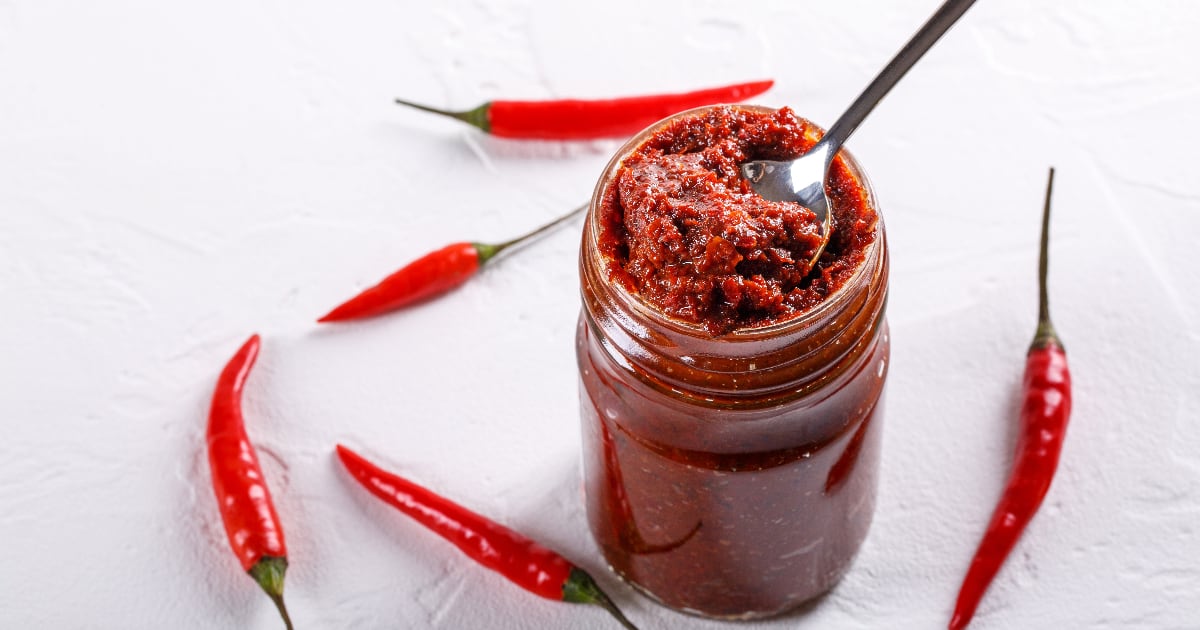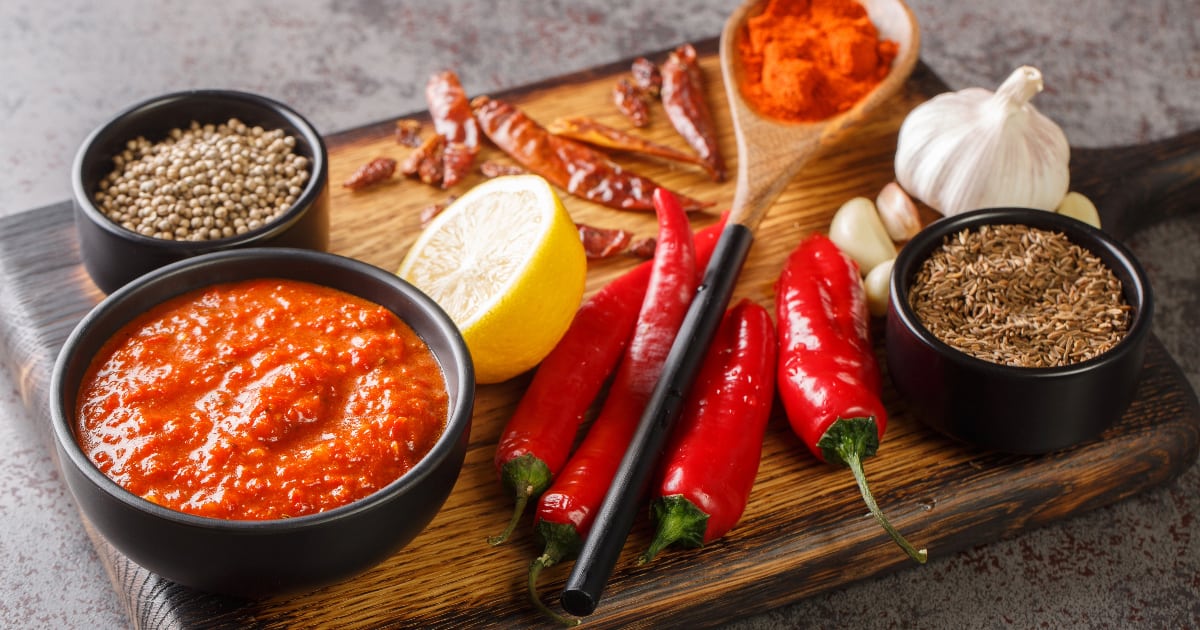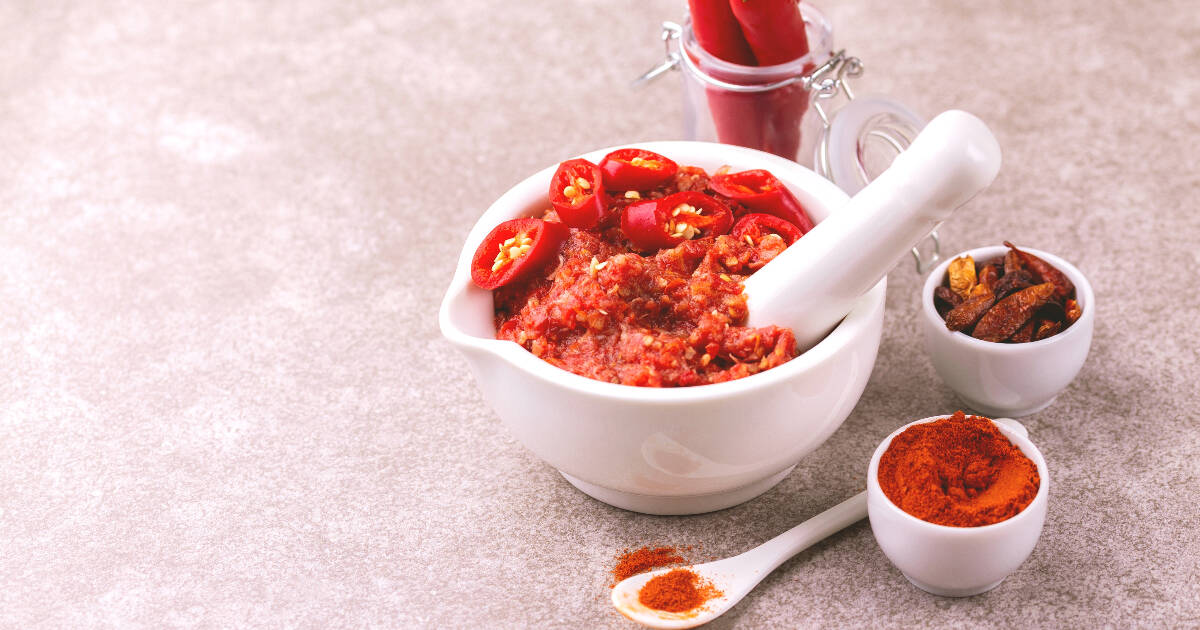Harissa paste is a versatile condiment that adds a big, bold flavor to many dishes. This fiery North African sauce combines chilies, garlic, spices, and olive oil into a spreadable blend.

Harissa originated in Tunisia, and it remains an essential flavor in Maghrebi and Middle Eastern cooking.
Both store-bought and homemade versions create an instant flavor boost. Read on to learn all about harissa paste - from its flavor profile to how it's made, storage tips, and delicious ways to cook with it!
Harissa Paste Ingredients

The main ingredients in harissa paste are chili peppers, garlic, olive oil, tomatoes, spices like cumin, coriander, caraway seeds, and citrus juice. Regional variations exist, but harissa usually has a thick, spreadable texture and a fiery, aromatic flavor.
Harissa gets its heat from different types of chili peppers. Most recipes call for dried chilies which are rehydrated and blended into the paste. Common varieties include guajillo, New Mexico, arbol, and bird's eye chilies. Using multiple types of chilies creates a depth of flavor. The quantity and type of chilies impact the paste's spiciness. More chilies make it hotter.
Garlic is another star ingredient in harissa. When roasted or minced fresh, it adds a pungent, savory flavor that balances the chilies. Garlic's bold flavor also enhances harissa's aromatic qualities.
Good quality extra virgin olive oil provides a rich, smooth texture and mellow base notes. Lemon or lime juice often gets added to harissa. The acidity brightens the other robust flavors.
Tomato paste or roasted red peppers lend subtle sweetness and smokiness. They also give harissa its signature dark red hue.
Spices like cumin, coriander, and caraway seeds are toasted and then ground into the paste. They provide an underlying warmth and spice flavor.
How Harissa Paste is Made
Making homemade harissa paste is surprisingly easy. With a food processor or blender, you can make a batch in 30 minutes.
Here's how harissa paste is made:
- Soak dried chilies in hot water to rehydrate them. about 20-30 minutes.
- Toast whole spices like cumin, coriander, and caraway in a dry skillet. 1-2 minutes.
- Blend the rehydrated chilies with the roasted garlic, olive oil, tomato paste, lemon juice, and ground toasted spices. Puree into a smooth paste.
- Season to taste with additional salt, spices, or lemon juice if desired.
- Transfer to an airtight container. Cover with a thin layer of olive oil to prevent drying out. Refrigerate for up to 3 weeks.
That's all it takes to make flavorful homemade harissa paste! With a few simple ingredients and steps, you can create a versatile Middle Eastern chili sauce.
Tips for Making Harissa Paste
Small adjustments help customize and perfect your homemade harissa. Follow these tips for the best batch every time:
- Use a combination of chili peppers to create a depth of flavor. Mix dried guajillo, arbol, chipotle, and New Mexico for a complex taste.
- Remove chili seeds to make a milder paste. The seeds contain most of the heat.
- Roast garlic and vegetables for deeper, smokier notes. Char fresh peppers or tomatoes under a broiler before blending into the harissa.
- Toast spices like cumin and coriander before grinding. This intensifies their flavors.
- Let the paste rest overnight before using. This allows the flavors to fully develop.
- Add herbs and spices like mint, rosemary, paprika, or cinnamon. Get creative!
- Adjust consistency with more or less olive oil and lemon juice.
- Taste and season with extra salt, spices, or citrus as needed.
Uses for Harissa Paste

The uses for harissa paste are endless! This versatile condiment can spice up everything from meat to eggs, veggies, pasta, sandwiches, dips, and more.
Here are some delicious ways to use Harissa:
- Rub on chicken, beef, lamb, or fish before grilling or roasting.
- Stir into stews, tagines, chili, or curry for flavor and heat.
- Drizzle over hummus, baba ghanoush, and falafel.
- Toss with roasted or grilled vegetables like cauliflower, carrots, and eggplant.
- Mix into dressings and dips like yogurt, mayo, or tahini.
- Scoop onto pizzas, flatbreads, and sandwiches.
- Top burgers, hot dogs, and sausages.
- Scramble into eggs or fold into an omelet.
- Swirl into tomato sauce for pasta, chili, or meatballs.
- Spread on sandwiches with meat or veggies.
The options are endless with this flavor powerhouse paste! Adjust the amount based on your desired spice level.
How to Buy Harissa Paste
Look for prepared harissa paste at well-stocked grocery stores, Middle Eastern markets, or online.
When buying pre-made:
- Seek out brands from North Africa, like Tunisia or Morocco for authentic flavor.
- Check the ingredients list. Quality harissa contains just chili peppers, oil, garlic, spices, and citrus.
- Avoid additives like preservatives, thickeners, and artificial flavors.
- Look for smooth consistency without large chunks.
- Select based on your desired spice level. Mild, medium, or hot.
Quality harissa paste can also be found at restaurants and specialty food stores. Look for jars and tubes from brands like Mina, Zamouri Spices, and Haven's Kitchen. Trader Joe's makes a popular version too.
For maximum freshness and flavor control, making your own harissa paste is best. But store-bought works great in a pinch!
How to Store Harissa Paste
To maintain freshness and flavor, proper storage of harissa paste is important:
- Refrigerate in an airtight container for up to 3 weeks.
- Freeze in ice cube trays or freezer bags for 6 months. Thaw overnight before using.
- Cover with a thin layer of olive oil in the container to prevent drying out and extend shelf life.
- Flavor improves with 1-2 days of refrigeration as spices meld.
With its vibrant red color and zippy flavor, harissa paste is a versatile way to add bold North African spice to everything from meat to eggs, hummus, pasta, sandwiches, and more! Making your own allows you to control the flavor and heat level perfectly suited to your taste.
FAQs
What makes harissa paste spicy?
The chili peppers are what give harissa paste its signature spicy kick. Most recipes use a blend of dried chilies like guajillo, arbol, and New Mexico varieties. These are rehydrated and incorporated into the paste. Both the type and quantity of chilies impact the heat level. Using more peppers or hotter varieties like bird's eye chilies makes it spicier.
Can you make vegetarian harissa?
Absolutely! Harissa is already vegetarian and vegan by nature. The main ingredients are chilies, garlic, olive oil, spices, and citrus juice. There is no need to substitute or remove ingredients to make it meat-free. Vegetarian harissa has the same authentic flavor.
What's the difference between harissa powder and paste?
Harissa powder is a dried spice blend containing the same chilies, spices, and garlic found in the paste. To use it, you must reconstitute the powder with oil and water. Harissa paste has a spreadable texture thanks to the inclusion of olive oil. The paste also hydrates the dried spices, intensifying their flavor.
How long does homemade harissa last?
When stored properly, homemade harissa paste is kept for 2-3 weeks refrigerated. For longer storage, freeze the paste in ice cube trays or bags for up to 6 months. Make sure to cover the paste with a thin layer of olive oil before storing it to prevent drying out.
Conclusion
From its Tunisian origins, harissa paste has become a versatile, ubiquitous condiment across North Africa and the Middle East. Both store-bought and homemade versions pack a spicy, garlicky punch of flavor.
This chili paste can transform everything from eggs to meat, hummus, pasta, pizza, sandwiches, and more.

